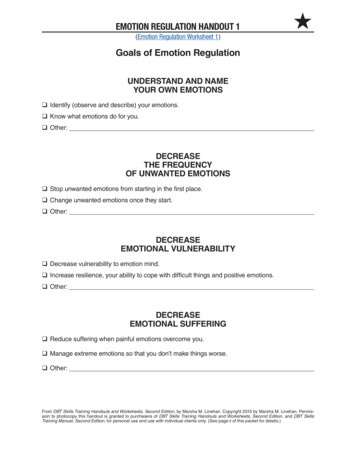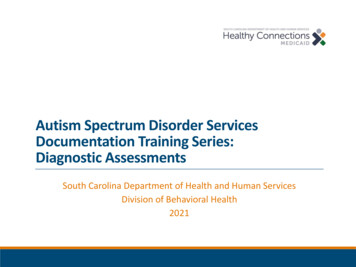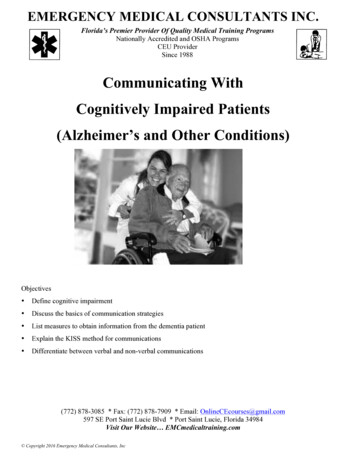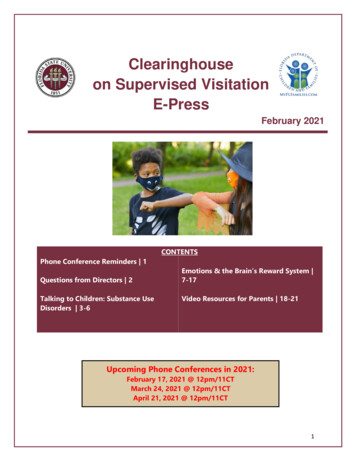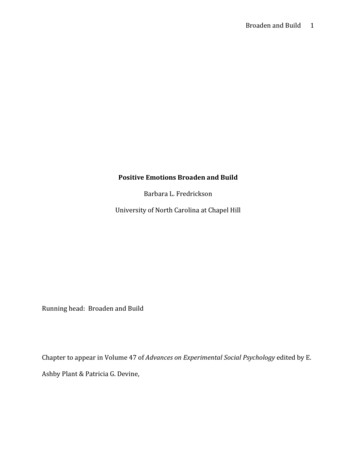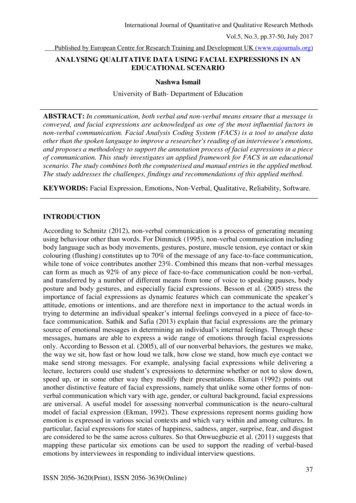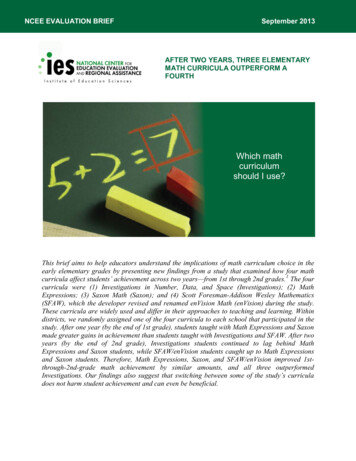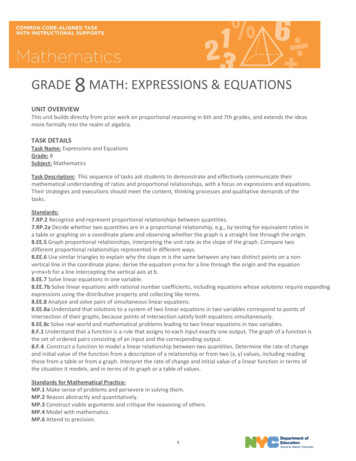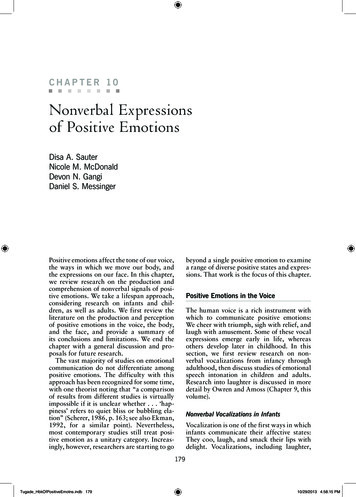
Transcription
C h a pter 1 0Nonverbal Expressionsof Positive EmotionsDisa A. SauterNicole M. McDonaldDevon N. GangiDaniel S. MessingerPositive emotions affect the tone of our voice,the ways in which we move our body, andthe expressions on our face. In this chapter,we review research on the production andcomprehension of nonverbal signals of positive emotions. We take a lifespan approach,considering research on infants and children, as well as adults. We first review theliterature on the production and perceptionof positive emotions in the voice, the body,and the face, and provide a summary ofits conclusions and limitations. We end thechapter with a general discussion and proposals for future research.The vast majority of studies on emotionalcommunication do not differentiate amongpositive emotions. The difficulty with thisapproach has been recognized for some time,with one theorist noting that “a comparisonof results from different studies is virtuallyimpossible if it is unclear whether . . . ‘happiness’ refers to quiet bliss or bubbling elation” (Scherer, 1986, p. 163; see also Ekman,1992, for a similar point). Nevertheless,most contemporary studies still treat positive emotion as a unitary category. Increasingly, however, researchers are starting to gobeyond a single positive emotion to examinea range of diverse positive states and expressions. That work is the focus of this chapter.Positive Emotions in the VoiceThe human voice is a rich instrument withwhich to communicate positive emotions:We cheer with triumph, sigh with relief, andlaugh with amusement. Some of these vocalexpressions emerge early in life, whereasothers develop later in childhood. In thissection, we first review research on nonverbal vocalizations from infancy throughadulthood, then discuss studies of emotionalspeech intonation in children and adults.Research into laughter is discussed in moredetail by Owren and Amoss (Chapter 9, thisvolume).Nonverbal Vocalizations in InfantsVocalization is one of the first ways in whichinfants communicate their affective states:They coo, laugh, and smack their lips withdelight. Vocalizations, including laughter,179Tugade HbkOfPositiveEmotns.indb 17910/29/2013 4:58:15 PM
180II. BIOLOGY OF POSITIVE EMOTIONgurgling, positively toned babbling, and cooing, appear to have an inherent signal valueand are used as indices of positive affect inobservational research on infant temperament (e.g., Goldsmith & Rothbart, 1999;Hane, Fox, Henderson, & Marshall, 2008).Laughter emerges when infants arebetween 2 and 5 months of age (Nwokah,Hsu, Dobrowolska, & Fogel, 1994; Washburn, 1929) and appears to index intensepositive emotion and arousal (Sroufe &Waters, 1976). Initial laughs sound muchlike early vowel-like vocalizations, butmothers appear to recognize and commenton them (Nwokah & Fogel, 1993). Laughingbecomes more frequent between the secondmonth and the second year of life (Nwokahet al., 1994), and during this period physically stimulating games, such as tickling, arepotent elicitors of laughter (see Owren &Amoss, Chapter 9, this volume). Between 6and 12 months of age, infants become morelikely to laugh in response to social games,such as peekaboo, as they simultaneouslybecome more active in these games (Sroufe& Waters, 1976). Furthermore, infant andmother laugh onsets and offsets occurincreasingly close in time between 12 and24 months, suggesting that laughter reflectsand supports increasing communicative synchrony in the second year (Nwokah et al.,1994).In contrast to laughter, many infantspeech- like vocalizations seem to acquire apositive signal value for the social partner orobserver because of the behavioral context inwhich they occur. Nonverbal vocalizationsin infants are typically thought to expresspositive emotions when they occur duringsmiles. Yale, Messinger, and Cobo-Lewis(2003) examined how infants at 3 and 6months coordinate vocalizations with facialexpressions. They found that vocalizationswere typically embedded within smiles: Theinfants smiled, vocalized, finished the vocalization, and only then terminated the smile.This suggests that the vocalizations mayemphasize the affective message providedby the smile. In support of this hypothesis,recent research indicates that listeners showonly moderate agreement when distinguishing the affective tenor of infant vocalizationsfrom listening to the vocalization alone;however, agreement increases substantiallywhen observers listen to the vocalizationTugade HbkOfPositiveEmotns.indb 180as they watch the infant (Franklin, Oller,Ramsdell, & Jhang, 2011).Nonverbal Vocalizations in AdultsIn contrast with the developmental researchin this area, several studies have differentiated among different kinds of nonverbal positive vocalizations in adults. Schröder (2003),for example, studied listeners’ perceptionof affect bursts of admiration, elation, andrelief. Affect bursts are “very brief, discrete,nonverbal expressions of affect in both faceand voice” (Scherer, 1994, p. 170). Thestudy found substantial variability in recognition across positive emotions. Whereasaffect bursts of admiration and relief werewell recognized, elation expressions seemedto lack a clear prototype. Schröder’s results,however, showed that some specific positiveemotions can be communicated via vocalsignals.Extending this research, Sauter and colleagues have examined nonverbal vocalizations of positive emotions that, unlike affectbursts, do not include facial expressions andneed not be brief. Sauter and Scott (2007)tested Ekman’s (1992) hypothesis that thereare several positive emotions with distinctnonverbal vocal expressions by examining enacted vocalizations of achievement/triumph, amusement, contentment, sensual pleasure, and relief. Among Englishand Swedish speakers, each positive emotion vocalization was well recognized, andlisteners consistently rated vocalizations asexpressing the intended emotion. Sauter,Eisner, Calder, and Scott (2010) examinedthe acoustic cues used by listeners to judgeemotions from nonverbal vocalizations.They found that each set of emotion ratingswas predicted by a unique combination ofacoustic measures. Relief and achievementratings were predicted by different subsetsof spectral and pitch cues, whereas amusement, contentment, and pleasure were predicted by different combinations of spectraland envelope information. This suggeststhat listeners employ different acoustic cuesto distinguish different positive emotions.In a related study, Sauter, Eisner, Ekman,and Scott (2010) examined the productionand recognition of emotion vocalizationsamong English and Himba individuals,the latter from remote, culturally isolated10/29/2013 4:58:16 PM
10. Nonverbal Expressions of Positive EmotionsNamibian villages. Different positive emotions yielded different patterns of results.Laughter was recognized bidirectionally,with listeners inferring amusement fromlaughs by their own and the other group.Triumph and sensual pleasure vocalizations were recognized within each group,but not across groups, suggesting that thedevelopment of these vocalizations dependson culture- specific input. Both English andHimba individuals produced acousticallysimilar sighs in response to relief scenarios.Himba listeners, however, did not recognizerelief vocalizations from either group, suggesting that sighs are ambiguous signals thatcan communicate a range of affective states.In a follow- up study (Sauter, 2010), English and Himba individuals matched laughter to a smiling facial expression. Nonverbal vocalizations of other positive emotionswere not cross- culturally associated with thesmiling facial expression. However, only oneexemplar of smiling was provided, leavingopen the possibility that different positivevocalizations might be associated with different smile configurations.Simon- Thomas, Keltner, Sauter, Sinicropi- Yao, and Abramson (2009) examined vocalizations of 22 different emotions, including13 positive states. They found that, as in Sauter and colleagues’ (Sauter, Eisner, Calder &Scott, 2010; Sauter, Eisner, Ekman, & Scott,2010; Sauter & Scott, 2007) work, relief andamusement were the two best- recognizedpositive emotions. More generally, analysisof listeners’ errors revealed that incorrectclassifications mainly occurred within emotion families (e.g., “self- conscious,” “prosocial”), suggesting that vocal signals offunctionally similar emotions may overlapacoustically.The Development of Positive ProsodyIn addition to nonverbal expressions, positive emotions can be expressed vocallythrough speech prosody. Studies in this areahave predominantly focused on the perception, rather than the production, of speechprosody. The early development of prosodyperception is often investigated via lookingtime measures in which infants are “asked”to relate a positive speech segment to asmile. Infants can associate facial and vocalexpressions of positive emotion in their par-Tugade HbkOfPositiveEmotns.indb 181181ents by 3 months of age (Kahana- Kalman& Walker- A ndrews, 2001; Montague &Walker- A ndrews, 2002), and can associatethese expressions in an unfamiliar adult inthe context of a peekaboo game by 4 months(Montague & Walker- A ndrews, 2001).Between ages 5 and 7 months, infants canassociate facial and vocal positive expressions in unfamiliar adults outside the context of familiar games (Walker- A ndrews,1997). In these studies, infants discriminatepositive expressions from neutral and negative expressions. Research on the perceptionof different types of positive emotion is notavailable until much later in development.We know of no research on positive emotional prosody production in older children. Recent research, however, has begunto explore children’s ability to distinguishamong different types of positive speechalongside nonverbal vocalizations, usingadult expressions of triumph, amusement,contentment, and relief as stimuli (Sauter,Panattoni, & Happe, 2013). Using forced- choice tasks, Sauter and colleagues (2013)found that children as young as 5 years ofage were proficient in interpreting positiveemotional cues from vocal signals, althoughperformance for both nonverbal and verbalstimuli improved through 10 years (the oldestage studied). Consistent with evidence fromadults (see below), children’s accuracy washigher for nonverbal vocalizations than forspeech stimuli (Hawk, Van Kleef, Fischer, &van der Schalk, 2009). This is likely becauseprocessing speech automatically engagesmechanisms involved in decoding speech,even when it is irrelevant to the task at hand.In contrast, nonverbal vocalizations are notlanguage- like, so resources are fully focusedon understanding the nonverbal emotionalinformation. Recognition was better thanchance for both speech and nonverbal stimuli for all of the positive emotions studied,however, demonstrating that children areable to infer positive emotional states fromdifferent vocal cues. Furthermore, the twotasks were sensitive to individual differences, with high correspondence betweenchildren’s performance across the tasks.In adults, listeners across several culturesfind “happy” speech more difficult to identify than speech expressing other emotions(e.g., Scherer, Banse, & Wallbott, 2001; butsee Pell, Monetta, Paulmann, & Kotz, 2009,10/29/2013 4:58:16 PM
182II. BIOLOGY OF POSITIVE EMOTIONfor a different pattern of results). Could itbe that an array of distinct positive emotions would be better recognized than happiness? In a meta- analysis of vocal communication of emotion, Juslin and Laukka(2003) differentiated between happinessand love– tenderness. “Happiness” includeda range of positive emotional states, including cheerfulness, elation, enjoyment, andjoy, whereas love– tenderness included statessuch as affection, love, tenderness, and passion. The meta- analysis found evidence forsome degree of recognition of prosody forthese two broad groups of positive emotions.Happy speech was characterized by fastspeech rate, medium to high voice intensity,high pitch level, and substantial pitch variability. In contrast, tenderness typically hadslow speech rate, low voice intensity, lowpitch level, and little pitch variability.Although studies have described theprosody associated with laughter in speech(Nwokah, Hsu, Davies, & Fogel, 1999) andexcitement (Trouvain & Barry, 2000), thereis little research comparing speech intonation among different positive emotions. Twostudies using acted emotional speech haveincluded a variety of positive emotions. Banseand Scherer (1996) examined the recognition of emotions varying in arousal. Theyfound that elation and happiness (unlikeother emotion pairs) were rarely confusedwith each other, suggesting that elation andhappiness are two distinct emotions. Similarly, Sauter (2006) found that listeners wereable to identify a range of positive emotionsfrom inflected speech, recognizing triumph,amusement, contentment, and sensual pleasure at better- than- chance levels. Consistentwith findings from nonverbal vocalizations,amusement was the best recognized of thepositive emotions. These studies offer evidence that several positive emotions can bedistinguished via speech prosody.Adopting a free- naming approach, Cowieand Cornelius (2003) tested listeners’ recognition of emotions using segments of spontaneous speech. Using these naturalisticstimuli, they found that listeners inferredseveral positive emotional states from speechinflection, including excitement, amusement, affection, love, pleasure, relaxation,and happiness. Cowie and Cornelius alsonoted that the emotions were typically perceived to be of fairly weak intensity, suggest-Tugade HbkOfPositiveEmotns.indb 182ing that emotions expressed in speech tendto be weak to moderately strong and mixedrather than pure. They suggested that thismay be because full-blown emotion expression competes for control with the cognitivesystems that underpin the production of fluent speech.Conclusions on Positive Emotionsin the VoiceIn infants, the early- emerging associationbetween laughter and tickling in both humanand nonhuman primate infants (DavilaRoss, Owren, & Zimmermann, 2009), andthe increasing use of laughter in synchronized social games, is relatively well understood. Other vocalizations, such as gurglingand cooing, are used to tap individual differences in positive expressivity (Fox, Henderson, Rubin, Calkins, & Schmidt, 2001;Goldsmith & Rothbart, 1999; Hane et al.,2008) but have not been validated withrespect to the contexts in which they occuror the manner in which they are perceivedby observers. Almost nothing is knownabout positive vocal expressions in childrenbetween 1 and 5 years of age, although olderchildren have been found to recognize arange of positive states from both speech andnonspeech vocalizations. To our knowledge,no work to date has assessed children’s vocalproduction of positive emotions; research ininfants includes both production and perception, but research later in the lifespantypically only examines recognition (butsee Cowie & Cornelius, 2003). This raisesthe question of how the production of vocalsignals of positive emotion, as well as theirrecognition, develops beyond infancy.Adults are sensitive to a range of positive emotions in vocal signals, particularlyin nonverbal vocalizations, suggesting thatthe voice may be a particularly importantmeans of signaling positive affective information. Notably, amusement and reliefvocalizations are well recognized and showcross- cultural consistency; for other positiveemotions, such as triumph, vocalizationsvary more across cultural groups. These differences highlight the importance of considering a range of distinct positive emotionswhen assessing cross- cultural differencesand consistencies in vocal and other expressions. Some positive vocalizations— such as10/29/2013 4:58:16 PM
10. Nonverbal Expressions of Positive Emotionslaughter and perhaps sighs of relief— may befixed signals in human beings.From childhood on, positive emotions,like negative emotions, are less easily identified from speech prosody than nonverbalvocalizations. Whether this is due to emotions expressed in speech tending to be of aweaker intensity or because the acoustic cuesused in emotional communication competewith those employed in speech productionis an important question for future work toaddress. We now turn to bodily actions thatcommunicate positive affect.Bodily Expressions of Positive EmotionAlthough research in the domain of bodilyexpressions of positive emotions is limited,studies of infants, children, and adults haverevealed that positive emotion is expressedthrough the body in various ways fromearly in life. We discuss two broad domainsof bodily expressions of positive emotion:touch and postural cues.A Positive TouchIn young infants, touch is affected by caregivers’ responsivity during interactions.Moszkowski and Stack (2007) found that5-month-old infants tend to use static touch(e.g., touching without moving their hands)during naturalistic interactions with theirmothers. Infants use more reactive (e.g., pat,pull, grab) and soothing (e.g., stroke, finger, mouth) types of touch during periods ofexperimenter- requested maternal unresponsiveness (the still face). By 7 months of age,infants begin to display affectionate touchbehaviors, such as patting, hugging, andkissing, which increase through 11 months(Landau, 1989). The majority of thesetouch behaviors are directed at the primarycaregiver, suggesting that they are directedexpressions of positive emotion. However,there is no evidence to date that infants ofthis age use specific forms of touch to communicate different types of positive emotion.Warm touch between parent and childis associated with positive developmental outcomes in infancy. Anisfeld, Casper,Nozyce, and Cunningham (1990) randomlyassigned mothers soft baby carriers (“Snugglis”) designed to increase physical contactTugade HbkOfPositiveEmotns.indb 183183with their infants. They found that infantsin the soft baby carrier condition were morelikely to be securely attached at 13 monthsof age than were comparison children. Likewise, Weiss, Wilson, Hertenstein, and Campos (2000) found an association between“nurturing touch” and secure attachment.At older ages (5- and 6-year-olds), Oveis,Gruber, Keltner, Stamper, and Boyce (2009)found associations between warm familytouch and smile intensity in children. Thesefindings suggest that from early infancy,touch may be an important modality forcommunicating positive emotion that facilitates the development of secure attachment.Touch between adults is a topic of emergingresearch. In a pioneering study, Hertenstein,Keltner, App, Bulleit, and Jaskolka (2006)asked whether adults could identify specific emotions from the experience of beingtouched by a stranger on the arm or hand,without being able to see the touch. Theyfound that participants were able to decodeemotions including love, gratitude, and sympathy via touch at better- than- chance levels(see Hertenstein & Keltner, 2010, for evidence of gender asymmetries in decoding).The researchers also examined the mostcommonly used types of touch for expressing different emotions, and found that lovewas typically signaled with stroking, gratitude was communicated with a handshake,and sympathy was expressed with a pattingmovement. Furthermore, participants wereable to infer emotions by merely watchingothers communicate via touch. The findingthat participants are able to decode positive emotions from being touched has sincebeen replicated and extended to the broadstate of happiness (Hertenstein, Holmes,McCullough, & Keltner, 2009).In addition to signaling specific positiveemotions, touch may also influence howwell people work together. A study by Kraus,Huang, and Keltner (2010) that examinedprofessional basketball players found thatmore physical contact between playerson the same team was associated with thetouched individual and team performingbetter later in the season. This finding heldeven when accounting for player status, preseason expectations, and early season performance. Results of this study support theproposition that touch can facilitate socialbonding and promote cooperation and per-10/29/2013 4:58:16 PM
184II. BIOLOGY OF POSITIVE EMOTIONformance between adults, and that touchmay be a preferred modality for communicating prosocial emotions within a group.Gestural and Postural Expressionsof Positive EmotionsInfants express positive emotions throughposture, gestures, and physical motion. Ina frequently used temperament measure forinfants and young children (Lab-TAB), positive motor activities coded include clapping,waving the arms in excitement, and bangingone’s hands on a table (Goldsmith & Rothbart, 1999). These patterns of movementare assumed to have a particular positiveexpressive value because they occur duringsituations designed to elicit positive emotion(“joy/pleasure episodes”). There has, however, been little systematic documentationof the proportion of infants who respondto these episodes with these types of movements, or reports on whether these movements also occur during other situations.“Pride” is an example of a positivelyvalenced self- conscious emotion, generallydefined as the experience of positive feelings toward the self. Pride typically occursafter successful completion of a goal, and itsexpression involves postural and gestural,as well as facial, actions. Three-year-oldsare more likely to exhibit signs of pride inresponse to successful completion of relativelydifficult tasks compared to less difficult orfailed tasks (Belsky, Domitrovich, & Crnic,1997). Children as young as 4 years of agecan accurately recognize images of pride atabove- chance levels when asked whether anadult in a photo is proud, happy, or surprised(Tracy, Robins, & Lagattuta, 2005). Lewis,Takai- Kawakami, Kawakami, and Sullivan(2010) investigated pride in response to successful completion of a challenging game inJapanese and American children, as indexedby behaviors such as an erect posture, smiling, and positive self- evaluation. The proportion of early school- age children expressingpride varied by cultural group, with markedly more American than Japanese childrenexhibiting signs of pride (Lewis et al., 2010).Expressions of pride, then, may vary, even inschool- age children, to reflect cultural valuessuch as individual self- expression (Dennis,Cole, Zahn- Waxler, & Mizuta, 2002; Messinger & Freedman, 1992).Tugade HbkOfPositiveEmotns.indb 184There is a considerable body of workshowing that pride is reliably communicated via postural cues in adults acrossseveral different cultures (for a review, seeTracy, Weidman, Cheng, & Martens, Chapter 17, this volume). Most notably, there isevidence for cross- cultural recognition ofthe pride expression via postural cues byindividuals from a preliterate, isolated culture in Burkina Faso, West Africa, as wellas by North Americans (Tracy & Robins,2008). Both groups could reliably recognizeexpressions of pride, regardless of whetherthe displays were produced by African orAmerican targets. The Burkinabe individuals were unlikely to have learned the prideexpression through cross- cultural transmission, as their exposure to people from outside their own cultural group was very limited. Further evidence for the cross- culturalconsistency of the pride display comes froma study by Tracy and Matsumoto (2008),which examined displays produced by blindathletes in response to winning ParalympicJudo matches. Photographs of participantsfrom different nations showed that thosewho had won produced behaviors associated with pride expressions, including raising their arms, tilting their heads back, smiling, and expanding their chests, which is theconfiguration of cues recognized by observers as communicating pride (Tracy & Robins, 2007).Aside from pride, there has been a paucity of research on gestural and posturalexpressions of positive emotion in childrenand adults. Compared to other basic emotions, happiness appears to be the most difficult emotion to recognize from whole-bodyexpressions (de Gelder & Van den Stock,2011), but there have been few attempts touse bodily cues to differentiate more specificpositive emotions. However, one notablestudy found evidence for an associationbetween gestural/postural movements andlove. Gonzaga, Keltner, Londahl, and Smith(2001) examined couples in romantic relationships taking part in a series of interactions. Four different nonverbal affiliationcues (head nods, Duchenne smiles, gesticulation, and forward leans) were correlated withself- reported feelings and partner estimatesof love. These findings suggest the potentialof research investigating the robustness andcross- cultural validity of gestural, bodily,10/29/2013 4:58:16 PM
10. Nonverbal Expressions of Positive Emotionsand facial signs of affiliative positive emotions.Conclusions on Positive Emotionsin Bodily ExpressionsTouch may be a preferred modality for communicating prosocial emotions to those closeto us. Infants use touch to express attachment needs to caregivers, and increased nurturing touch from caregivers is associatedwith secure infant attachment. In older children, warm family touch is associated withchildren’s smile intensity. In these contexts,touch appears to reflect and support a positive emotional interplay between child andcaregivers. Touch between adults predictsindividuals working well together, and several prosocial positive emotions, includinglove, gratitude, and sympathy, can be communicated via touch.With the exception of pride, little isknown about how positive emotions canbe expressed using whole-body movements.Pride is associated with a well- establishedset of postural cues and is consistently recognized and displayed by both childrenand adults across cultures. Unfortunately,studies in children have generally neglectedto describe the specific ways that childrenexpress pride (e.g., erect posture may be theonly postural cue) or how pride expressionschange with development. Careful description of changes or continuities in prideexpressions across development would provide a firm basis for continued explorationsof the expression and recognition of pridein cross- cultural contexts. Investigation ofpride expressions in blind individuals of various ages who do not have visual experiencewith pride displays represents rich groundfor continued innovative research.Positive Emotion in the FaceThe smile is remarkably well recognized asa facial signature of positive emotion, withsmiling expressions typically identified moreeasily than any other emotion in studiesincluding one category of positive emotion(see Elfenbein & Ambady, 2002, for a meta- analysis). Throughout the lifespan, smilesare caused by the zygomaticus major muscle (AU12 in the anatomically based FacialTugade HbkOfPositiveEmotns.indb 185185Action Coding System [FACS] and its application to infants [BabyFACS]), which pullsthe lip corners sideways and slightly upward(Ekman & Friesen, 1978; Oster, 2006).There is, however, more than one way tosmile. Duchenne smiles are caused by theadditional action of orbicularis oculi (parslateralis), which raises the cheeks aroundthe eyes and, in adults, produces crow’s feet(i.e., horizontal lines extending laterallyfrom the outside corners of the eyes) (Duchenne, 1862/1990; Ekman, Davidson, & Friesen, 1990). Duchenne smiles index positiveemotion, although this may be true of othersmiles as well (see discussion below). Smilesmay also involve lip parting and mouthopening. Mouth opening is a characteristicof the smiles of infants, children, and nonhuman primates, and perhaps of adults aswell (Messinger & Fogel, 2007). Below weexamine the literature on perceiving andproducing different types of smiles acrossinfants, children, and adults.The Development of Positive FacialExpressions in InfancyInfants’ production of smiles begins at birth,but contrary to common belief, neonatalsmiling is not caused by gas. Infant smilesare linked not to time since last feeding, aswould be predicted by the gas hypothesis,but to infant behavioral states, such as activesleep (Emde & Koenig, 1969). Neonatessmile during active sleep and drowsy states.In these states, around one-half of infantsobserved for 6 minutes exhibited bilateralDuchenne smiles, approximately one-thirdof which were at a moderate intensity level(Messinger et al., 2002). The relativelymature form of these smiles and their occurrence during sleep states characterized byhigh levels of limbic activity suggest a possible link to positive emotion (Dondi et al.,2007). While some neonatal smiles occuramid other mouthing and dimpling actions,making them harder to discern, others occurin the absence of such movements. Longerduration neonatal smiles are more likely tobe recognized as smiles by naive observers, suggesting that these in particular maybe perceived as expressing positive emotion(Dondi et al., 2007).Recent research indicates that neonatesalso smile in awake–alert states (Cec-10/29/2013 4:58:16 PM
186II. BIOLOGY OF POSITIVE EMOTIONchini, Baroni, Vito, & Lai, 2011; Dondi etal., 2007). Cecchini and colleagues (2011)found that whereas smiles during activesleep tended to occur with the mouthclosed, smiles during awake periods tendedto involve mouth opening. Tactile stimulation whose intensity was responsive to theinfant’s behavior— an unseen adult movinga finger the infant was grasping— appearedto differentially elicit open-mouth smiles,many of which also involved eye constriction (Cecchini et al., 2011). This suggeststhe contextual sensitivity of smiles early inlife, and the possibility that open-mouthsmiles are differentially reflective of arousalgenerated by interaction compared to othersmiles.Early positive emotion expression is social.Evidence from blind infants, for example,suggests that visually mediated social interaction is necessary to support the development of normative smiling expressions in re
found that elation and happiness (unlike other emotion pairs) were rarely confused with each other, suggesting that elation and happiness are two distinct emotions. Simi-larly, Sauter (2006) found that listeners were able to identify a range of positive emotions from inflected speech, recognizing triumph, amusement, contentment, and sensual plea-
